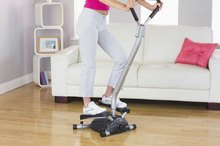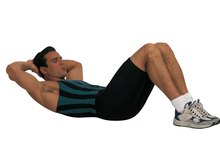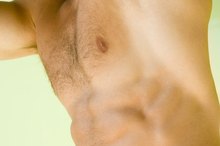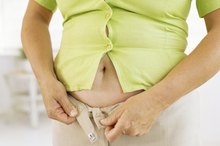What does fact checked mean?
At Healthfully, we strive to deliver objective content that is accurate and up-to-date. Our team periodically reviews articles in order to ensure content quality. The sources cited below consist of evidence from peer-reviewed journals, prominent medical organizations, academic associations, and government data.
- ACE Fitness: Trimming Off Fat
- ACE Fitness: Myths and Misconceptions: Spot Reduction and Feeling the Burn
- Journal of Exercise Rehabilitation: The Effects of Abdominal Draw-In Manuever
- Journal of Exercise Rehabilitation: The Effects of Abdominal Draw-In Manuever
- Journal of Physical Therapy Science: Comparison of the Effects of Hollowing and Bracing Exercises on Cross-sectional Areas of Abdominal Muscles in Middle-aged Women
- Journal of Physical Therapy Science: Comparison of the Effects of Hollowing and Bracing Exercises on Cross-sectional Areas of Abdominal Muscles in Middle-aged Women
The information contained on this site is for informational purposes only, and should not be used as a substitute for the advice of a professional health care provider. Please check with the appropriate physician regarding health questions and concerns. Although we strive to deliver accurate and up-to-date information, no guarantee to that effect is made.
Abdominal Compression for Weight Loss
Whether you’ve recently had a baby, are recovering from abdominal surgery or are just trying to shape up a long period of being sedentary, abdominal compression exercises are a gentle and effective way to ease back into exercise. Exercises that compress the abdominal muscles won’t make you lose weight; however, they can help nip in your waist while you’re undertaking a healthful diet and a well-rounded exercise routine.
Read more about how to lose abdominal fat quick.
Tips
You may have seen advertisements for various kinds of abdominal compression belts claiming to boost the number of calories you burn when exercising— or to specifically make you lose belly fat. It's better, though, to save your money for a new pair of running shoes. There’s little scientific research per se on the phenomenon of the compression belt for weight loss. The American Council on Exercise is crystal clear in stating that there’s no such thing as “spot reduction.” Consumer Reports, did however, test the "As Seen on TV” Belly Burner waist band and found that it did not affect the number of calories burned during exercise.
A Weighty Matter
“If you have a big belly and you want a flat one, you’re doing to have to lose some weight,” says personal trainer David Knox, author of Body School: A New Guide to Improved Movement in Daily Life. “It’s even possible to have six-pack abs but not be able to see them because they’re covered in a layer of fat.”
If losing weight is your main concern, diet will have to lead the way. To lose a pound of fat, you will need to burn 3,500 more calories than you consume. While it’s hard to rack up that kind of caloric deficit with exercise alone, working out will turbocharge your dieting efforts. Strength training boosts calorie burning because muscle burns more calories than fat tissue — not to mention the fact that you burn a lot of calories building muscle. As you put on muscle mass, your resting metabolic rate increases as well, causing you to burn more calories when you’re not even doing anything.
Although most abdominal compression exercises may seem fairly passive, done properly they can have a noticeable effect on your profile and your posture. Doing standing abdominal contractions can correct the tendency to stand with the pelvis tilted forward, which causes a belly pooch. In addition, they work the transverse abdominis, the deepest-lying of the abdominal muscles and one that’s strongly associated with lower back pain.
- “If you have a big belly and you want a flat one, you’re doing to have to lose some weight,” says personal trainer David Knox, author of Body School: A New Guide to Improved Movement in Daily Life. “ As you put on muscle mass, your resting metabolic rate increases as well, causing you to burn more calories when you’re not even doing anything.
Abdominal Hollowing
Exercises to Get Rid of a Muffin Top
Learn More
Lying down with knees at an 80 degree angle and feet on the floor, slowly pull the navel deeply into the lower spine. Maintain the contraction for several seconds while continuing to breathe lightly. Keep pelvis and chest static while doing the exercise, which can also be done standing up or sitting. Also called the Drawing-In Maneuver or Stomach Vacuum, this exercise was shown in a study in the Journal of Physical Therapy Science to increase thickness of the transverse abdominis and the internal and external obliques.
- Lying down with knees at an 80 degree angle and feet on the floor, slowly pull the navel deeply into the lower spine.
- Keep pelvis and chest static while doing the exercise, which can also be done standing up or sitting.
Abdominal Bracing
If you've done the yoga pose plank, you've performed abdominal bracing. Tighten your stomach muscles as if you're preparing for a punch in the gut -- that's bracing. It can also be done standing or sitting. In a study in the February 2014 Journal of Physical Therapy Science, abdominal bracing was shown to strengthen the rectus abdominis, both internal obliques, and both external obliques 5.
Read more about why belly fat is hard to lose.
- If you've done the yoga pose plank, you've performed abdominal bracing.
Related Articles
References
- ACE Fitness: Trimming Off Fat
- ACE Fitness: Myths and Misconceptions: Spot Reduction and Feeling the Burn
- Consumer Reports: Belly Burner Put to the Test
- Journal of Exercise Rehabilitation: The Effects of Abdominal Draw-In Manuever
- Journal of Physical Therapy Science: Comparison of the Effects of Hollowing and Bracing Exercises on Cross-sectional Areas of Abdominal Muscles in Middle-aged Women
- University of New Mexico: Superb Abs Manual, by Len Kravitz, PhD
- Hauggaard A, Persson AL. Specific spinal stabilisation exercises in patients with low back pain—a systematic review. Phys. Ther. Rev. 2007;12:233–248.
- Hodges PW, Richardson CA. Delayed postural contraction of transversus abdominis in low back pain associated with movement of the lower limb. J Spinal Disord. 1998 Feb;11(1):46-56.
Writer Bio
Martin Booe writes about health, wellness and the blues. His byline has appeared in the Washington Post, the Los Angeles Times and Bon Appetit. He lives in Los Angeles.









